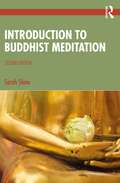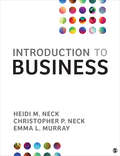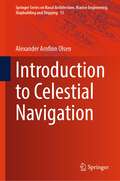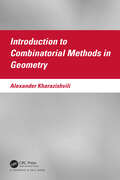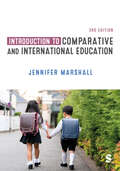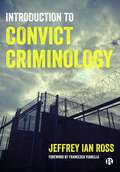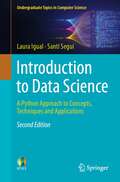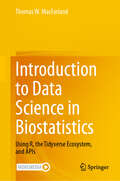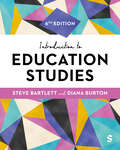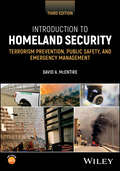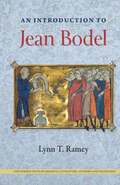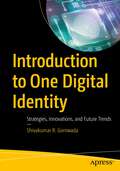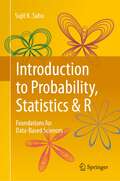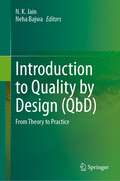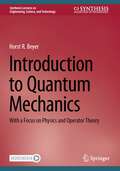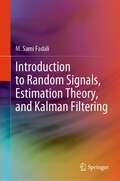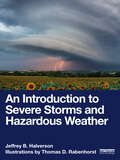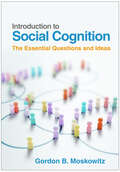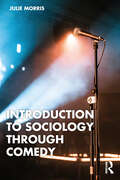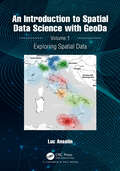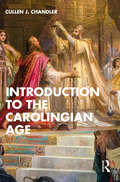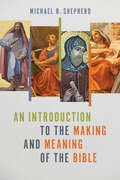- Table View
- List View
Introduction to Buddhist Meditation
by Sarah ShawThis lively introduction to Buddhist meditation offers students and practitioners alike a deeper understanding of what meditation is and its purpose and place in the context of different Buddhist schools. The historical background and geographical spread of Buddhist meditation is explored alongside an examination of the development of meditative practices. Chapters cover basic meditative practice, types of meditation, meditation in different regions, meditation and doctrine, and the role of chanting within meditation. Although not a practical guide, Introduction to Buddhist Meditation outlines the procedures associated with Buddhist practices and suggests appropriate activities, useful both for students and interested Buddhists. Vivid quotations from Buddhist texts and carefully selected photographs and diagrams help the reader engage fully with this fascinating subject.Thoroughly revised throughout, this new edition also features a glossary and key, making it ideal reading for students approaching the topic of Buddhist meditation for the first time.
Introduction to Business
by Heidi M. Neck Christopher P. Neck Emma L. MurrayIntroduction to Business ignites student engagement and prepares students for their professional journeys, regardless of their career aspirations. Best-selling authors Heidi M. Neck, Christopher P. Neck, and Emma L. Murray inspire students to see themselves in the world of business and to develop the mindset and skillset they need to succeed. A diverse set of impactful examples and cases, from inspiring startups and small businesses to powerful corporations, illustrate how businesses can prosper and create positive impact.
Introduction to Business
by Heidi M. Neck Christopher P. Neck Emma L. MurrayIntroduction to Business ignites student engagement and prepares students for their professional journeys, regardless of their career aspirations. Best-selling authors Heidi M. Neck, Christopher P. Neck, and Emma L. Murray inspire students to see themselves in the world of business and to develop the mindset and skillset they need to succeed. A diverse set of impactful examples and cases, from inspiring startups and small businesses to powerful corporations, illustrate how businesses can prosper and create positive impact.
Introduction to Celestial Navigation (Springer Series on Naval Architecture, Marine Engineering, Shipbuilding and Shipping #15)
by Alexander Arnfinn OlsenThis book focuses on Coastal and Ocean Navigation with an emphasis on celestial navigation techniques as a ‘back up’ in the event digital technologies fail.It deals with the main themes and principles of celestial navigation (including time). It covers the syllabus for deck officers working towards the Officer of the Watch (OOW) certificate of competence (COC) awarded by the Maritime and Coastguard Agency (MCA), and for Royal Navy navigation officers working towards achieving the equivalent Navigational Watch Certificate (NWC). The NWC is equivalent to the certificate awarded by the MCA to OOWs in the Merchant Service under the international Standardisation of Training, Certification and Watchkeeping (STCW) agreements. The detailed theory of celestial navigation is provided.
Introduction to Combinatorial Methods in Geometry
by Alexander KharazishviliThis book offers an introduction to some combinatorial (also, set-theoretical) approaches and methods in geometry of the Euclidean space Rm. The topics discussed in the manuscript are due to the field of combinatorial and convex geometry.The author’s primary intention is to discuss those themes of Euclidean geometry which might be of interest to a sufficiently wide audience of potential readers. Accordingly, the material is explained in a simple and elementary form completely accessible to the college and university students. At the same time, the author reveals profound interactions between various facts and statements from different areas of mathematics: the theory of convex sets, finite and infinite combinatorics, graph theory, measure theory, classical number theory, etc.All chapters (and also the five Appendices) end with a number of exercises. These provide the reader with some additional information about topics considered in the main text of this book. Naturally, the exercises vary in their difficulty. Among them there are almost trivial, standard, nontrivial, rather difficult, and difficult. As a rule, more difficult exercises are marked by asterisks and are provided with necessary hints.The material presented is based on the lecture course given by the author. The choice of material serves to demonstrate the unity of mathematics and variety of unexpected interrelations between distinct mathematical branches.
Introduction to Comparative and International Education
by Jennifer MarshallThis book introduces major themes surrounding comparative and international education, giving you a nuanced understanding of key debates, and thinkers, and the tools necessary to conduct comparisons using secondary sources. Social, economic, historical, and cultural factors are examined in order to investigate the varied contexts in which education takes place around the globe. This new edition includes: New case studies touching on contemporary issues from decolonising the curriculum to the impact of the Covid-19 pandemic on education A new introduction outlining the features of the book and how to use them Updated educational data from around the world and new links to external resources Dr Jennifer Marshall is Senior Lecturer in Education at the University of Derby.
Introduction to Comparative and International Education
by Jennifer MarshallThis book introduces major themes surrounding comparative and international education, giving you a nuanced understanding of key debates, and thinkers, and the tools necessary to conduct comparisons using secondary sources. Social, economic, historical, and cultural factors are examined in order to investigate the varied contexts in which education takes place around the globe. This new edition includes: New case studies touching on contemporary issues from decolonising the curriculum to the impact of the Covid-19 pandemic on education A new introduction outlining the features of the book and how to use them Updated educational data from around the world and new links to external resources Dr Jennifer Marshall is Senior Lecturer in Education at the University of Derby.
Introduction to Convict Criminology
by Jeffrey Ian RossConvict criminology (CC) is based on the belief that the convict’s voice has been traditionally ignored or marginalized in scholarship and policy debates, and that its inclusion can positively impact the fields of corrections, criminology, criminal justice, and policy making. Designed for students, scholars, and activists worldwide this is the first sole-authored book to comprehensively explain the CC approach to scholarship, teaching, mentorship, and prison and criminal justice activism. It reviews the history and scholarship on this engaging field and the challenges that the approach has encountered. It features: • exhibit boxes • keywords • test questions - including multiple choice, short answer and essay format.
Introduction to Data Science: A Python Approach to Concepts, Techniques and Applications (Undergraduate Topics in Computer Science)
by Laura Igual Santi SeguíThis accessible and classroom-tested textbook/reference presents an introduction to the fundamentals of the interdisciplinary field of data science. The coverage spans key concepts from statistics, machine/deep learning and responsible data science, useful techniques for network analysis and natural language processing, and practical applications of data science such as recommender systems or sentiment analysis. Topics and features: Provides numerous practical case studies using real-world data throughout the book Supports understanding through hands-on experience of solving data science problems using Python Describes concepts, techniques and tools for statistical analysis, machine learning, graph analysis, natural language processing, deep learning and responsible data scienceReviews a range of applications of data science, including recommender systems and sentiment analysis of text data Provides supplementary code resources and data at an associated website This practically-focused textbook provides an ideal introduction to the field for upper-tier undergraduate and beginning graduate students from computer science, mathematics, statistics, and other technical disciplines. The work is also eminently suitable for professionals on continuous education short courses, and to researchers following self-study courses.
Introduction to Data Science in Biostatistics: Using R, the Tidyverse Ecosystem, and APIs
by Thomas W. MacFarlandIntroduction to Data Science in Biostatistics: Using R, the Tidyverse Ecosystem, and APIs defines and explores the term "data science" and discusses the many professional skills and competencies affiliated with the industry. With data science being a leading indicator of interest in STEM fields, the text also investigates this ongoing growth of demand in these spaces, with the goal of providing readers who are entering the professional world with foundational knowledge of required skills, job trends, and salary expectations. The text provides a historical overview of computing and the field's progression to R as it exists today, including the multitude of packages and functions associated with both Base R and the tidyverse ecosystem. Readers will learn how to use R to work with real data, as well as how to communicate results to external stakeholders. A distinguishing feature of this text is its emphasis on the emerging use of APIs to obtain data.
Introduction to Education Studies
by Steve Bartlett Diana M BurtonIn this fully updated sixth edition of this much-loved textbook, students will be introduced to different ways of looking at education, supported by links to classic and contemporary research. Built around the essential themes of psychology, history, policy and sociology, this new edition explores a range of contemporary topics found on Education studies courses, including: UK education policy since 2020, including policy responses to the COVID-19 pandemic Decolonising the curriculum and social justice Education studies and student employability Expanded coverage of cognitive psychological theories of learning
Introduction to Education Studies
by Steve Bartlett Diana M BurtonIn this fully updated sixth edition of this much-loved textbook, students will be introduced to different ways of looking at education, supported by links to classic and contemporary research. Built around the essential themes of psychology, history, policy and sociology, this new edition explores a range of contemporary topics found on Education studies courses, including: UK education policy since 2020, including policy responses to the COVID-19 pandemic Decolonising the curriculum and social justice Education studies and student employability Expanded coverage of cognitive psychological theories of learning
Introduction to Homeland Security: Terrorism Prevention, Public Safety, and Emergency Management
by David A. McEntireExplore the growing concerns about security with this vital book Homeland Security has never been a more important part of the American social and political fabric. Risk assessment, attack prediction and prevention, preparedness measures, response to terrorist activity, and natural disaster management all fall under the purview of homeland security. It is a key focus of the US security state, which has expanded massively in recent decades. Introduction to Homeland Security provides an overview of this subject for professors, students, and practitioners in the field. Drawing upon a rich foundation of scholarship and academic literature, it focuses principally on terrorism prevention and protection, and offers new content related to novel threats and security concerns. Its practitioner-centered approach and attention to both governmental and non-governmental stakeholders make it an indispensable introduction to the subject. Readers will also find: Coverage of the four traditional phases of emergency management New and additional treatment of border control, drug trafficking, organized crime, mass shootings, protests, riots, pandemics, and climate change Companion websites including extensive pedagogical materials, student self-assessment tests, and an image gallery Introduction to Homeland Security is ideal for professors and students in homeland security and emergency management programs, as well as practitioners involved in this important profession.
An Introduction to Jean Bodel (New Perspectives on Medieval Literature: Authors and Traditions)
by Lynn T. RameyBringing the work of a highly influential medieval French writer to English-speaking audiences for the first time This book explores the life and works of Jean Bodel, an influential author who lived in twelfth-century Arras, France. A versatile poet, playwright, and epic writer who established new genres such as fabliaux and the mystery play, Bodel remains relatively unknown to Anglophone audiences. Lynn Ramey offers translations and summaries of works never published before in English while delving into Bodel’s historical and cultural context. After a brief introduction to the poet, Ramey highlights the stimulating and cosmopolitan environment of Arras, considering the influence of the Crusades and social movements in shaping Bodel’s works. Next, Ramey provides an extensive survey of all of Bodel’s known writing across his prolific career by genre, from his most well-known work, The Play of Saint Nicholas (Le Jeu de saint Nicolas), to his final piece, Farewell (Les Congés), which offers important insight into his diagnosis of leprosy toward the end of his life. Ramey translates several pieces including pastourelles, fabliaux, and selections from the Song of the Saxons (Chanson des Saisnes). The book also includes information on Bodel’s sources, a chronology, and a glossary. With much of the existing scholarship on Bodel only available in French, this book bridges a gap in knowledge of the poet and serves as a useful resource for both students and specialists. An Introduction to Jean Bodel allows a broader audience to engage with the writer’s wide-ranging work and contributions to literary history.A volume in the series New Perspectives on Medieval Literature: Authors and Traditions, edited by R. Barton Palmer and Tison Pugh
Introduction to One Digital Identity: Strategies, Innovations, and Future Trends
by Shivakumar R. GoniwadaExplore the dynamics of digital identity, a crucial component in today’s modern technology-driven era. This engaging book offers a deep understanding of how digital identity is evolving rapidly, why it’s so significant, and offers organizations, regulatory bodies, and academicians the strategies needed to adopt secure decentralized digital identity features effectively. It’s a must-read for those aiming to grasp the intricacies of digital identity and leverage it for future innovation and security.The book begins by redefining digital identity, examining its evolution and the profound impact it has on both individuals and organizations. It then delves into the development of digital identity strategies, laying the foundation for future digital transformations. Covering a wide range of topics, the book discusses the innovation, challenges, and technological exploration in digital identity. A special focus is given to biometric technologies and the implementation of decentralized digital identities, addressing critical areas such as identity governance, blockchain, AI and advanced biometrics. The book also investigates the implications of digital identity across various industries, including cross border travel, healthcare, social media, finance, metaverse, IoT etc. finally the book provides not only emerging trends but offers a glimpse into the future digital identity. Whether you’re a tech professional, business leader, student or simply keen on understanding the impact of digital advancements, this book promises to offer insightful perspectives and practical solutions for navigating the complex world of digital identity. It underscores the importance of identity in spearheading digital innovation, making it a key resource for anyone looking to stay ahead in the digital landscape. As you reach its conclusion, you’ll be equipped with a wealth of knowledge and insights that are crucial in today’s digital era.What You'll LearnDigital identity strategies and their role in shaping the future of digital identityDifferent facets of digital identitySpecifics of biometric technologies and decentralized digital identity Industry specific digital identity and its implementationCrucial aspects of privacy, ethics, and secure in the context of digital identityWho This Book Is ForSoftware professionals, security practitioners, architects, senior managers, executives, and students who are interested in digital identity.
Introduction to Probability, Statistics & R: Foundations for Data-Based Sciences
by Sujit K. SahuA strong grasp of elementary statistics and probability, along with basic skills in using R, is essential for various scientific disciplines reliant on data analysis. This book serves as a gateway to learning statistical methods from scratch, assuming a solid background in high school mathematics. Readers gradually progress from basic concepts to advanced statistical modelling, with examples from actuarial, biological, ecological, engineering, environmental, medicine, and social sciences highlighting the real-world relevance of the subject. An accompanying R package enables seamless practice and immediate application, making it ideal for beginners. The book comprises 19 chapters divided into five parts. Part I introduces basic statistics and the R software package, teaching readers to calculate simple statistics and create basic data graphs. Part II delves into probability concepts, including rules and conditional probability, and introduces widelyused discrete and continuous probability distributions (e.g., binomial, Poisson, normal, log-normal). It concludes with the central limit theorem and joint distributions for multiple random variables. Part III explores statistical inference, covering point and interval estimation, hypothesis testing, and Bayesian inference. This part is intentionally less technical, making it accessible to readers without an extensive mathematical background. Part IV addresses advanced probability and statistical distribution theory, assuming some familiarity with (or concurrent study of) mathematical methods like advanced calculus and linear algebra. Finally, Part V focuses on advanced statistical modelling using simple and multiple regression and analysis of variance, laying the foundation for further studies in machine learning and data science applicable to various data and decision analytics contexts. Based on years of teaching experience, this textbook includes numerousexercises and makes extensive use of R, making it ideal for year-long data science modules and courses. In addition to university courses, the book amply covers the syllabus for the Actuarial Statistics 1 examination of the Institute and Faculty of Actuaries in London. It also provides a solid foundation for postgraduate studies in statistics and probability, or a reliable reference for statistics.
Introduction to Quality by Design (QbD): From Theory to Practice
by N. K. Jain Neha BajwaThis book offers a comprehensive exploration of the Quality by Design (QbD) methodology, guiding readers from theory to practical application with accessible examples. It equips readers with both foundational and advanced knowledge, emphasizing the critical parameters necessary for designing pharmaceutical products that meet the highest quality standards. The book goes beyond theory to demonstrate how to effectively implement QbD principles in various aspects of pharmaceutical research and development, including analytical methods, formulation, and packaging processes. Through a step-by-step approach, it prepares researchers in pharmaceutical sciences, as well as professionals in the pharmaceutical and healthcare industries (including suppliers), to successfully integrate QbD into their work.
Introduction to Quantum Mechanics: With a Focus on Physics and Operator Theory (Synthesis Lectures on Engineering, Science, and Technology)
by Horst R. BeyerThis book presents an introduction to quantum mechanics that consistently uses the methods of operator theory, allowing readers to develop a physical understanding of quantum mechanical systems. The methods of operator theory are discussed throughout the book and presented with a mathematically rigorous approach. The author describes in detail how to use the methods of operator theory for analyzing quantum mechanical systems, starting with the definition of the involved physical operators (observables) up to the calculation of their spectra, spectral measures, and functional calculus. In addition, the book includes the construction of exponential functions of the involved Hamilton operators that solve the problem of time evolution.
Introduction to Random Signals, Estimation Theory, and Kalman Filtering
by M. Sami FadaliThis book provides first-year graduate engineering students and practicing engineers with a solid introduction to random signals and estimation. It includes a statistical background that is often omitted in other textbooks but is essential for a clear understanding of estimators and their properties. The book emphasizes applicability rather than mathematical theory. It includes many examples and exercises to demonstrate and learn the theory that makes extensive use of MATLAB and its toolboxes. Although there are several excellent books on random signals and Kalman filtering, this book fulfills the need for a book that is suitable for a single-semester course that covers both random signals and Kalman filters and is used for a two-semester course for students that need remedial background. For students interested in more advanced studies in the area, the book provides a bridge between typical undergraduate engineering education and more advanced graduate-level courses.
An Introduction to Severe Storms and Hazardous Weather
by Jeffrey B. HalversonThis book presents a deep and encompassing survey of severe weather in all its forms. An Introduction to Severe Storms and Hazardous Weather is an exciting new textbook that allows students to learn the principles of atmospheric science through the drama, exhilaration, and even tragedy of severe weather.Balancing breadth and depth, Jeffrey B. Halverson adeptly combines a short, accessible introduction to the basic principles of meteorology with detailed coverage on large- and small-scale weather hazards. He draws on specific up-to-date case studies from North America to illustrate the cause of meteorological events including hurricanes, heavy snow and ice, floods, and tornadoes. Unlike existing books on the market, Halverson delves deep into the societal impacts of these events, drawing on examples from agriculture, utility infrastructure, and commercial aviation. Each chapter also features high-quality, customized color artwork by Thomas D. Rabenhorst that helps to enhance and embed learning.Thorough in its scope, and written with an impeccable focus on the science, this book will be an essential resource for introductory undergraduate courses in severe weather, natural hazards, and extreme meteorology. It is also an excellent supplemental textbook for courses on meteorology and atmospheric science.
Introduction to Social Cognition: The Essential Questions and Ideas
by Gordon B. MoskowitzWhy are first impressions so powerful? How do we &“know&” what others are like when we cannot read their minds? How can scientists measure biases that people do not want to admit--or do not know they have? This engaging text delves into social cognition by exploring major questions in the field through an everyday lens. Students are introduced to core concepts and processes pertaining to how people come to know themselves and understand the behavior of others. Classic and contemporary findings and experimental methods are explained. The text connects the research to pressing contemporary problems--the roots of political polarization, why even rational people fall prey to misinformation, and the best ways to reduce prejudice. Boxed definitions of key terms are included throughout.
Introduction to Sociology Through Comedy
by Julie MorrisQuestioning society and one’s place in it is a common theme in both comedy and sociology. Understanding and subverting hierarchies and norms, exploring deviance and taboos, and relating lived experience to broader questions all hold a crucial place for them both.Introduction to Sociology Through Comedy teaches foundational sociological concepts using comedy, first considering the history of sociology before employing examples from comedians – including standalone comedy bits, sketches, characters, and scenes – to illustrate a specific theory, concept, or social phenomenon. The profession of comedy is then used as a case study for the application of sociological concepts, such as impression management, social stratification, racial segregation, deviance, and stigma, allowing readers to gain familiarity with the concepts while simultaneously practicing their application.This book explains why we laugh by applying theories of humor, which will bolster students’ understanding of sociological principles by forcing them to question their own assumptions – helping them to put why they laugh into sociological terms.
An Introduction to Spatial Data Science with GeoDa: Volume 1: Exploring Spatial Data
by Luc AnselinThis book is the first in a two-volume series that introduces the field of spatial data science. It offers an accessible overview of the methodology of exploratory spatial data analysis. It also constitutes the definitive user’s guide for the widely adopted GeoDa open-source software for spatial analysis. Leveraging a large number of real-world empirical illustrations, readers will gain an understanding of the main concepts and techniques, using dynamic graphics for thematic mapping, statistical graphing, and, most centrally, the analysis of spatial autocorrelation. Key to this analysis is the concept of local indicators of spatial association, pioneered by the author and recently extended to the analysis of multivariate data.The focus of the book is on intuitive methods to discover interesting patterns in spatial data. It offers a progression from basic data manipulation through description and exploration to the identification of clusters and outliers by means of local spatial autocorrelation analysis. A distinctive approach is to spatialize intrinsically non-spatial methods by means of linking and brushing with a range of map representations, including several that are unique to the GeoDa software. The book also represents the most in-depth treatment of local spatial autocorrelation and its visualization and interpretation by means of GeoDa.The book is intended for readers interested in going beyond simple mapping of geographical data to gain insight into interesting patterns. Some basic familiarity with statistical concepts is assumed, but no previous knowledge of GIS or mapping is required.Key Features:• Includes spatial perspectives on cluster analysis• Focuses on exploring spatial data• Supplemented by extensive support with sample data sets and examples on the GeoDaCenter websiteThis book is both useful as a reference for the software and as a text for students and researchers of spatial data science.Luc Anselin is the Founding Director of the Center for Spatial Data Science at the University of Chicago, where he is also the Stein-Freiler Distinguished Service Professor of Sociology and the College, as well as a member of the Committee on Data Science. He is the creator of the GeoDa software and an active contributor to the PySAL Python open-source software library for spatial analysis. He has written widely on topics dealing with the methodology of spatial data analysis, including his classic 1988 text on Spatial Econometrics. His work has been recognized by many awards, such as his election to the U.S. National Academy of Science and the American Academy of Arts and Science.
Introduction to the Carolingian Age
by Cullen J. ChandlerIntroduction to the Carolingian Age provides an accessible history of western Europe in the eighth and ninth centuries, when arguably a truly European civilization emerged out of the transformed, former world of the Roman Empire.Through a thematical and chronological approach, this book explores the life, family, and period of Charlemagne in a clear and informative way. The secular aristocrats, ecclesiastical figures, and scholars associated with the Carolingian dynasty feature as partners in building the empire and guiding its development, and the social and cultural lives of people from the elite to the common classes are also examined. Through an engaging narrative, this study demonstrates that by the end of the ninth century, the royal house faced a series of challenges that brought about the devolution of the empire into smaller kingdoms and the loosening of the Carolingian family’s grip on monarchy. Based on up-to-date scholarship, Introduction to the Carolingian Age offers explanations of historical developments and discussions of key historiographical debates.This book is an essential resource for both undergraduate students and general readers with an interest in the history of the Carolingian period from 750–900.
An Introduction to the Making and Meaning of the Bible
by Michael B. ShepherdA comprehensive and orthodox guide to biblical origins and interpretation How did we get the Bible? How do we interpret it? And what does it mean for our lives today? Michael B. Shepherd introduces undergraduates and seminarians to these crucial questions in this reliable and thorough new textbook. Shepherd covers textual criticism, formation of the canon, and history of translation, all while remaining committed to Scripture&’s ultimate purpose—inviting us to salvation through Jesus Christ. Showing how the Bible directs its own interpretation, Shepherd encourages learners to listen to the Word of God, rather than twisting it to fit their own ends. His section-by-section treatment of the Bible encourages students to view the Bible as cohesive, while remaining sensitive to its diverse genres. Thorough and accessible, this textbook goes beyond typical historical introductions to spiritually form students learning to understand Scripture. An Introduction to the Making and Meaning of the Bible is the serious, evangelical introduction your students need and will reference for years to come.
